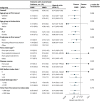Long-term efficacy of mycophenolate mofetil in myelin oligodendrocyte glycoprotein antibody-associated disorders: A prospective study
- PMID: 32170045
- PMCID: PMC7136046
- DOI: 10.1212/NXI.0000000000000705
Long-term efficacy of mycophenolate mofetil in myelin oligodendrocyte glycoprotein antibody-associated disorders: A prospective study
Abstract
Objective: To investigate whether the use of mycophenolate mofetil (MMF) could reduce the relapse risk in patients with myelin oligodendrocyte glycoprotein (MOG)-immunoglobulin G (IgG)-associated disorders (MOGADs).
Methods: This prospective observational cohort study included patients with MOGAD at Peking Union Medical College Hospital between January 1, 2017, and April 30, 2019. The patients were divided into 2 groups: those with (MMF+) or without (MMF-) MMF therapy. The primary outcome was relapse at follow-up. We used Cox proportional hazards models to calculate hazard ratios (HRs) for relapse.
Results: Seventy-nine patients were included in our MOG cohort. Fifty (63.3%) were adults at index date, and 47 (59.5%) were women. Fifty-four (68.4%) were in the MMF+ group, and 25 (31.6%) were in the MMF- group. Clinical and demographic factors, MOG-IgG titer, and follow-up time (median, 472.5 days for MMF+, 261.0 days for MMF-) were comparable between the groups. Relapse rates were 7.4% (4/54) in the MMF+ group and 44.0% (11/25) in the MMF- group. Of all potential confounders, only the use of MMF was associated with reduced risk of relapse. The HR for relapse among patients in the MMF+ group was 0.14 (95% CI, 0.05-0.45) and was 0.08 (95% CI, 0.02-0.28) in a model adjusted for age, sex, disease course, and MOG-IgG titer. MMF therapy also remained associated with a reduced relapse risk in sensitivity analyses. Only one patient (1.9%) discontinued MMF therapy because of adverse effect.
Conclusions: These findings provide a clinical evidence that MMF immunosuppression therapy may prevent relapse in patients with MOGAD.
Classification of evidence: This study provides class IV evidence that for patients with MOGAD, MMF reduces relapse risk.
Copyright © 2020 The Author(s). Published by Wolters Kluwer Health, Inc. on behalf of the American Academy of Neurology.
Figures



Similar articles
-
Differential efficacy of mycophenolate mofetil in adults with relapsing myelin oligodendrocyte glycoprotein antibody-associated disorders.Mult Scler Relat Disord. 2021 Aug;53:103035. doi: 10.1016/j.msard.2021.103035. Epub 2021 May 24. Mult Scler Relat Disord. 2021. PMID: 34077831
-
Time to Treat First Acute Attack of Myelin Oligodendrocyte Glycoprotein Antibody-Associated Disease.JAMA Neurol. 2024 Oct 1;81(10):1073-1084. doi: 10.1001/jamaneurol.2024.2811. JAMA Neurol. 2024. PMID: 39226035 Free PMC article.
-
Safety and efficacy of rituximab for relapse prevention in myelin oligodendrocyte glycoprotein immunoglobulin G (MOG-IgG)-associated disorders (MOGAD): A systematic review and meta-analysis.J Neuroimmunol. 2022 Mar 15;364:577812. doi: 10.1016/j.jneuroim.2022.577812. Epub 2022 Jan 13. J Neuroimmunol. 2022. PMID: 35063726
-
Frequency, characteristics, predictors and treatment of relapsing myelin oligodendrocyte glycoprotein antibody-associated disease (MOGAD).Mult Scler Relat Disord. 2024 Jul;87:105672. doi: 10.1016/j.msard.2024.105672. Epub 2024 May 10. Mult Scler Relat Disord. 2024. PMID: 38749350
-
Myelin-oligodendrocyte glycoprotein antibody-associated disease.Lancet Neurol. 2021 Sep;20(9):762-772. doi: 10.1016/S1474-4422(21)00218-0. Lancet Neurol. 2021. PMID: 34418402 Review.
Cited by
-
Myelin Oligodendrocyte Glycoprotein Antibody-Associated Disease: Current Insights into the Disease Pathophysiology, Diagnosis and Management.Int J Mol Sci. 2020 Dec 24;22(1):100. doi: 10.3390/ijms22010100. Int J Mol Sci. 2020. PMID: 33374173 Free PMC article. Review.
-
Efficacy and safety of immunosuppressive therapy in myelin oligodendrocyte glycoprotein antibody-associated disease: a systematic review and meta-analysis.Ther Adv Neurol Disord. 2021 Nov 10;14:17562864211054157. doi: 10.1177/17562864211054157. eCollection 2021. Ther Adv Neurol Disord. 2021. PMID: 34790259 Free PMC article.
-
Effectiveness and tolerability of different therapies in preventive treatment of MOG-IgG-associated disorder: A network meta-analysis.Front Immunol. 2022 Jul 26;13:953993. doi: 10.3389/fimmu.2022.953993. eCollection 2022. Front Immunol. 2022. PMID: 35958613 Free PMC article.
-
Recurrent Idiopathic Neuroretinitis: Anti-MOG Positive?J Investig Med High Impact Case Rep. 2023 Jan-Dec;11:23247096231206619. doi: 10.1177/23247096231206619. J Investig Med High Impact Case Rep. 2023. PMID: 37942586 Free PMC article.
-
Clinical characteristics and prognosis of pediatric myelin oligodendrocyte glycoprotein antibody-associated diseases in China.BMC Pediatr. 2022 Nov 18;22(1):666. doi: 10.1186/s12887-022-03679-3. BMC Pediatr. 2022. PMID: 36401212 Free PMC article.
References
-
- Reindl M, Di Pauli F, Rostasy K, Berger T. The spectrum of MOG autoantibody-associated demyelinating diseases. Nat Rev Neurol 2013;9:455–461. - PubMed
-
- Waters P, Woodhall M, O'Connor KC, et al. . MOG cell-based assay detects non-MS patients with inflammatory neurologic disease. Neurol Neuroimmunol Neuroinflamm 2015;2:e89 doi: 10.1212/NXI.0000000000000089. - DOI - PMC - PubMed
Publication types
MeSH terms
Substances
LinkOut - more resources
Full Text Sources
Research Materials
Miscellaneous
